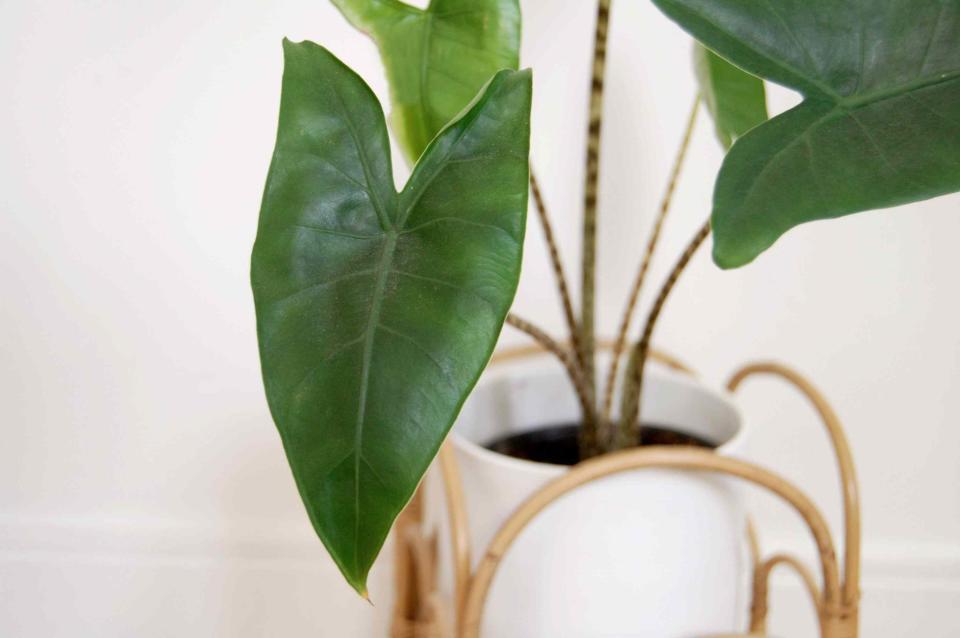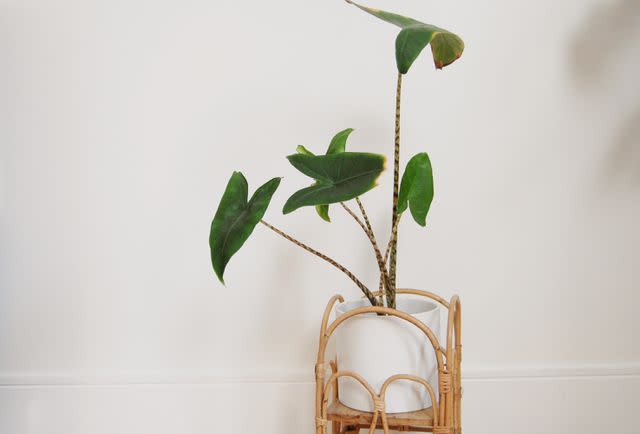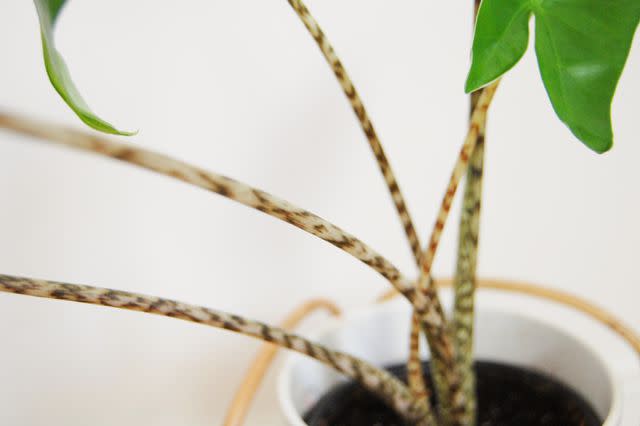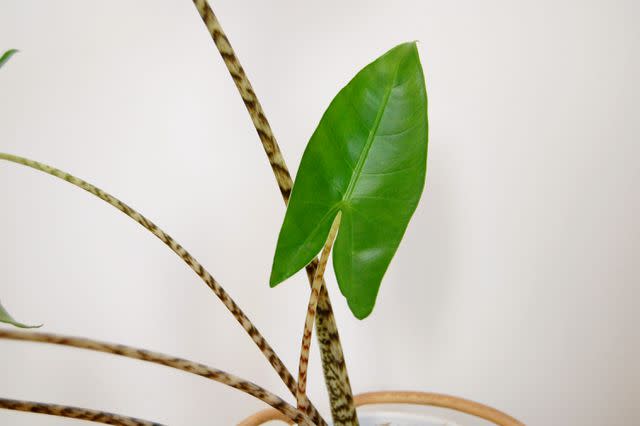How to Grow and Care for Alocasia Zebrina
Fast-growing houseplant prized for its zebra-striped stems

The Spruce / Cori Sears
Reviewed by Barbara Gillette
Alocasia zebrina, commonly called the zebra plant, is a tropical houseplant prized for its zebra-like stems. It is often difficult to find and tricky to grow since it is rather picky about its growing conditions. The plant has large, distinctly heart-shaped leaves that grow at the tip of the white-and-green striped stems. Native to the rainforests of the Philippines, this plant requires similar conditions—moist, rich, well-draining soil, dappled sunlight, warm temperatures, and high humidity. It’s a fast grower but it only blooms in ideal conditions and the flowers are usually concealed by the large leaves.
Alocasia is toxic to humans and pets.
How to Grow and Care for Alocasia Frydek
Common Name | Zebra plant, zebrina alocasia, tiger taro |
Botanical Name | Alocasia zebrina |
Family | Araceae |
Plant Type | Perennial, bulb |
Mature Size | 3 ft. tall, 3 ft. wide |
Sun Exposure | Partial |
Soil Type | Moist but well-draining |
Soil pH | Acidic, neutral |
Bloom Time | Spring, summer |
Flower Color | Green, white |
Hardiness Zones | 10-11 (USDA) |
Native Area | Asia |
Toxicity | Toxic to humans and pets |

The Spruce / Cori Sears

The Spruce / Cori Sears

The Spruce / Cori Sears
Alocasia Zebrina Care
Although it might seem difficult to keep this houseplant happy, it can thrive in most homes under the right conditions. The trick is understanding how it grows in its natural environment and trying to mimic those conditions. Here are the main care requirements for growing Alocasia zebrina:
Provide filtered light.
Keep soil moist but not soggy; the container should have ample drainage holes.
Ensure it is grown in warm temperatures and constant humidity.
Fertilize it monthly in the spring and summer.
Tips
Wiping down the leaves of your Alocasia zebrina every week or two will help to prevent dust accumulation and encourage photosynthesis—resulting in more vigorous growth.
Light
This tropical plant appreciates several hours of bright, indirect sunlight. If you have a north- or east-facing window, position your zebrina directly in front of it to maximize the light it receives. If you have a west- or south-facing window, set the plant back from the window by a couple of feet to avoid any harsh direct sunbeams. Or, filter direct light with a sheer curtain or window film. Alocasia is sensitive to leaf burn if exposed to too much light, but it is also prone to dropping leaves in low-light conditions.
Soil
When it comes to choosing the right soil, there are two things you need to keep in mind. First, alocasias require lots of nutrients to thrive, and second, they are prone to root rot and cannot tolerate wet feet. This means your soil mix should be rich in organic materials and well-draining. A mixture of equal parts potting soil, perlite or pumice, and coco peat is ideal.
Water
While the plant shouldn’t be left in soggy soil, it also doesn’t do well when its soil dries out. Ideally, the soil should stay consistently moist. Allow the top 1 inch of soil to dry slightly between waterings, and then water well—allowing the excess water to drain from the pot.
Temperature and Humidity
This tropical plant does not tolerate temperatures below 65 degrees F. It thrives in warm, slightly humid conditions, although it also does well in standard household conditions, which tend to be on the dry side. If your plant exhibits curling leaves, crispy edges, or dropping leaves, it may require more humidity. Placing a small humidifier close to the plant or moving it to a naturally humid room like a
bathroom, kitchen, or laundry room are great ways to improve humidity.
While this alocasia usually does best grown indoors as a houseplant, it is possible to grow it outdoors year-round in USDA zones 10 and 11.
Fertilizer
In addition to a nutrient-rich soil mix, fertilize your plant with a balanced houseplant fertilizer once a month during the spring and summer for vigorous growth. Follow fertilizer package instructions for application and amounts to use. Stop feeding during the fall and winter months when the plant is no longer actively growing.
Types of Alocasia Zebrina
With approximately 90 species in the Alocasia genus, they're primarily known for their supersized or uniquely veined leaves. Unlike the other species, Alocasia zebrina is prized for its uniquely striped stems and only grows about 3 feet tall. All alocasia produce flowers, although most are unremarkable, and they rarely flower indoors.
A. zebrina is native to the Philippines, and due to overharvesting, it's hard to find in the wild but continues to be cultivated by propagation methods. Other alocasia with unique stem coloration include:
Alocasia zebrina 'Reticulata': Culivar of A. zebrina; has a distinctive zebra print-like pattern on its stems but differs by having an interlacing or webbing pattern on its leaves
Alocasia macrorrhizos 'Stingray': Different species; has patterned stems reminiscent of A. zebrina; leaves resemble a stingray profile (the animal)
Alocasia macrorrhizos 'Black Stem': Another alocasia species; beloved for its uniquely black colored stem with large taro leaves
Pruning
This plant does not need pruning beyond removing damaged, dying, or dead foliage. Use sterilized pruning shears or snips to cut the problematic stem at its base, and always wear gloves since this plant is toxic.
Propagating Alocasia Zebrina
Alocasia is easily propagated by dividing, harvesting, and growing its corms or underground root structures. Both methods require a mature and healthy plant and are best done during regular repotting.
To propagate by division, follow these steps:
Remove the plant from its pot and gently remove any excess soil from the roots. Each plant will be growing from an individual bulb.
Divide the plant by separating the bulbs and roots from one another.
Pot the newly separated plants in a well-draining potting mix and water thoroughly. Place the plants in a location that receives bright, indirect light.
To propagate by growing corms, follow these steps.
Remove the plant from its pot and gently remove any excess soil from the roots.
Dig around the soil for small corms, which will be attached to the plant's roots. Carefully cut the corms from the roots at the base of the corm. The corms should be firm and round.
Peel the hard outside husk of the corm to expose the light green center and place the corm in a container with moistened sphagnum moss. Ensure the corm faces up with the pointy tip up and the rough side down.
Put a small resealable plastic bag over the container and close it to create a greenhouse-like environment, and place the container in a location that receives bright indirect light.
Once a week, unseal the bag for 10 to 15 minutes to encourage airflow. After a couple of weeks, you should see roots or foliage growing from the corms.
When the roots are at least 2 inches long, pot the new plants in a well-draining potting mix. Return them to a location with bright, indirect light and keep the soil evenly moist.
How to Grow Alocasia Zebrina From Seed
Alocasia zebrina is most commonly propagated by division; however, it is also possible to propagate it from seeds.
Extract the seeds from dried seed pods.
Scatter the seeds on the surface of moistened peat-based potting mix.
Sprinkle a thin layer of moistened potting mix on top.
Cover with a clear plastic bag or wrap, keep warm, and give indirect light.
Occasionally mist to keep conditions moist.
Keep it covered until the seed germinates, uncovering it daily for 15 minutes to one hour to provide fresh airflow.
Germination is slow, taking three weeks to three months.
Potting and Repotting Alocasia Zebrina
Alocasia zebrina prefers to be root-bound in a smaller pot, so it's not necessary to repot every year. When the pot begins to look cramped, or its roots are beginning to run rampant out of its drainage holes, repot Alocasia zebrina in a pot that is the next size up. Repotting stresses out most plants, so a day or two before repotting, water adequately.
Upend the plant in your hands, gently pull it out of its old container, and assess the roots. If its roots circle the bottom of the pot or you see two separate root systems, consider dividing your plant.
When dividing, remove most of the old soil surrounding the root system. Separate the plant carefully by untangling the roots and keeping them intact if possible. If not dividing and only repotting to the next size, keep the root ball intact with its soil, only knocking away old crusted soil around the periphery. Place several inches of new potting mix at the bottom of the plant, center the root ball in the pot, and fill in the sides, leaving at least an inch from the top of the pot's rim.
Common Pests & Plant Diseases
Keep an eye out for spider mites, fungus gnats, and mealybugs—all of which love the moist conditions in which Alocasia zebrina prospers. This plant is also susceptible to root rot, usually due to improper watering and soil drainage. Signs of root rot include yellowing leaves, dropping leaves, and brown mushy stems.
Common Problems With Alocasia Zebrina
Here are some common issues you might encounter with this tropical plant:
Yellow Leaves
Yellow leaves are usually caused by root rot due to overwatering, or by under watering, lack of humidity, or lack of light. You will need to assess your plant’s growing environment to figure out what may be causing its leaves to turn yellow.
Curling Leaves
Curling leaves usually indicate that your Alocasia zebrina is experiencing a lack of moisture or humidity. Ensure that you don’t allow your plant to dry out too much between waterings, and keep it away from drafty windows or air vents, which dry out the air.
Dropping Leaves
Leaves dropping off indicates that one or more things in your plant's growing environment are off. Lack of light, underwatering, overwatering, lack of humidity, and root rot are all possible causes of dropping leaves.
Drooping or Stem Bending
Droopy stems may indicate that the plant's stems are overladen with water. To fix this, allow the soil to almost completely dry out (about 2/3 of the pot). Also, check the drainage holes and make sure the soil drains properly. Occasionally, drooping or bending stems signify the opposite: the plant lacks water, nutrients, or light. If a stem looks damaged from significant bending, wrap it like a support bandage with florist tape to assist the plant in healing its stem.
Frequently Asked Questions
Is Alocasia zebrina fast-growing?
Under the right conditions, it is considered a fast-grower, adding a new leaf every week or two during active growth.
Why is my Alocasia zebrina not growing?
If your plant is not showing signs of growth, it is likely due to a lack of light or moisture or improper fertilization. Remember that this alocasia requires bright, indirect light; regular watering; and monthly fertilization during the spring and summer.
Can I propagate Alocasia zebrina by leaf cuttings?
Unlike other tropical aroids such as pothos and some philodendrons, Alocasias cannot be propagated by leaf cuttings. If you wish to propagate your Alocasia zebrina, you must do so by division or by harvesting and growing its corms.
The 15 Best Places to Buy Plants Online in 2023
Read the original article on The Spruce.

